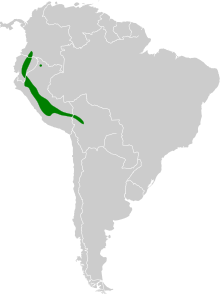Red-tailed eagle beak
| Red-tailed eagle beak | ||||||||||
|---|---|---|---|---|---|---|---|---|---|---|

Red-tailed eagle beak |
||||||||||
| Systematics | ||||||||||
|
||||||||||
| Scientific name | ||||||||||
| Eutoxeres condamini | ||||||||||
| ( Bourcier , 1851) |
The red-tailed eagle's beak or red tail sickle Schnabel ( Eutoxeres condamini ) is a species of bird from the family of hummingbirds (Trochilidae).
features
The red-tailed eagle's bill reaches a body length of 12 to 13 cm. It is similar to the eagle's beak , but the outer tail feathers are yellow-brown at the base, the tips are also white. On the sides of the neck there is a shiny blue-green spot that is missing in the eagle's beak. The underside is not black and white like the eagle's beak, but dashed soot-colored and yellowish white.
distribution
The distribution area includes Bolivia , Colombia , Ecuador and Peru .
Habitat and way of life
The behavior is similar to that of the eagle-beak hummingbird . Red-tailed eagle beak hummingbirds prefer the shady thicket, where they are usually seen individually in the undergrowth. Their flight is slow, with audible flapping of their wings. They feed on the nectar of heliconias , when probing the corolla they cling to the plants. They also take insects from trunks and branches. As far as is known, all breeding activities are carried out by the female and, like all hummingbirds, lay two eggs.
Systematics
Two subspecies are recognized:
- Eutoxeres condamini gracilis Berlepsch & Stolzmann , 1902 - Eastern Andes of Peru and northwest Bolivia.
- Eutoxeres condamini condamini ( Bourcier , 1851) - Eastern Andes from southeast Colombia to northern Peru.
Etymology and history of research
The type specimen of the red-tailed eagle's bill came from the area around Archidona on the eastern slopes of the Andes in the province of Napo and was brought by Bourcier on his return from Ecuador. Jules Bourcier described the species under the name Trochilus Condamini . Later it was assigned to the genus Eutoxeres . This name is derived from the Greek words "eu εὖ " for "beautiful, good" and "toxērēs τοξηρης " for "bowed, archer". Since the author described Trochilus Bougueri and Trochilus Godini in the same article, the specific epithet is very likely dedicated to Charles Marie de La Condamine (1701–1774), who worked with Pierre Bouguer (1698–1758) and Louis Godin (1704–1760) between 1735 and was on an expedition to the viceroyalty of Peru in 1744 . The Latin word "gracilis" stands for "slim, delicate".
literature
- Steven Leon Hilty , William Leroy Brown : A guide to the birds of Colombia . Princeton University Press, Princeton 1986, ISBN 978-0-691-08372-8 ( online [accessed May 27, 2014]).
- Thomas Scott Schulenberg, Douglas Forrester Stotz, Daniel Franklin Lane, John Patton O'Neill, Theodore Albert Parker III : Birds of Peru . Princeton University Press, Princeton, New Jersey 2007, ISBN 978-0-7136-8673-9 .
- James A. Jobling: Helm Dictionary of Scientific Bird Names . Christopher Helm, London 2010, ISBN 978-1-4081-2501-4 .
- Wolfgang Torge: History of geodesy in Germany . Hubert & Co. KG, Göttingen 1986, ISBN 978-3-11-019056-4 ( online [accessed June 2, 2014]).
- Jules Bourcier: Note on our espèces de trochilidées . In: Revue et magasin de zoologie pure et appliquée (= 2 ). tape 3 , 1851, pp. 96-98 ( online [accessed June 2, 2014]).
- Hans Hermann Carl Ludwig von Berlepsch, Jan Sztolcman: On the Ornithological Researches of Jean Kalinowski in Central Peru . In: Proceedings of the General Meetings for Scientific Business of the Zoological Society of London . tape 2 , no. 1 , 1902, pp. 18–60 ( online [accessed June 2, 2014]).
Web links
- Eutoxeres condamini inthe IUCN 2013 Red List of Threatened Species . Listed by: BirdLife International, 2012. Retrieved June 2, 2014.
- BirdLife International: Species Factsheet - Buff-tailed Sicklebill ( Eutoxeres condamini ) . Retrieved June 2, 2014.
- Videos, photos and sound recordings of Buff-tailed Sicklebill (Eutoxeres condamini) in the Internet Bird Collection
- Red-tailed sickle-beak ( Eutoxeres condamini ) at Avibase; Retrieved June 2, 2014.
- Eutoxeres condamini in the Integrated Taxonomic Information System (ITIS). Retrieved May 27, 2014.
- xeno-canto: Sound recordings - Buff-tailed Sicklebill ( Eutoxeres condamini )
Individual evidence
- ↑ Thomas Scott Schulenberg et al., P. 212
- ^ A b Steven Leon Hilty et al., P. 257
- ^ Steven Leon Hilty et al., P. 250
- ^ IOC World Bird List Hummingbirds
- ↑ Hans Hermann Carl Ludwig von Berlepsch et al., P. 19
- ↑ a b Jules Bourcier, p. 96
- ↑ James A. Jobling, p. 154
- ↑ Wolfgang Torge, p. 61
- ↑ James A. Jobling, p. 176
